Chronology, Geochemistry and Geological Significance of Epo Granite Intrusion, Southern Jiangxi
-
摘要: 赣南鹅婆岩体位于南岭东西向构造岩浆带与武夷山北北东向构造带结合部位,地处于都—青塘古生代盆地西缘,出露面积达200 km2。岩体主体为黑云母二长花岗岩,其构造位置特殊,周边成矿条件有利,西侧银坑矿田内部和外围分别发育金银铅锌贵多金属矿和钨多金属矿。本文在岩体地质工作的基础上,应用激光剥蚀多接收器电感耦合等离子体质谱(LA-MC-ICP-MS)技术对鹅婆黑云母二长花岗岩进行了锆石U-Pb定年;结合元素地球化学数据讨论了其岩浆系列和岩石成因;并与区内成矿岩浆岩进行对比,探讨其成矿潜力。鹅婆花岗岩体的侵入年龄为(412.5±1.7) Ma,花岗岩中含富铝矿物,主量和微量元素地球化学显示其属于高钾钙碱性-钾玄岩系列,为强过铝质的S型花岗岩,是新元古代壳层沉积变质泥岩在加里东晚期重熔侵入的产物。与加里东期和燕山期成钨锡花岗岩的对比研究表明,鹅婆岩体在形成过程中发生了W、Sn等成矿元素的富集。本文研究结果一方面证明前人获得的全岩Rb-Sr等时线年龄(307 Ma)代表的是成岩期后所经历的一次地质事件;同时表明加里东期花岗岩也有钨锡矿成矿的潜力。
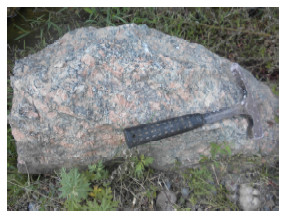
-
关键词:
- 赣南 /
- 鹅婆岩体 /
- LA-MC-ICP-MS /
- 加里东晚期 /
- 成矿作用
Abstract: The Epo intrusion with an exposed area of 200 km2, is mainly composed of biotite monzonitic granite, and is located on the western margin of the Yudu-Qingtang basin, the conjunction of E-W trending Nanling tectonic-magmatic belt and the NNE trending Wuyishan tectonic belt. Situated in such a special tectonic position, this region is advantageous to mineralization. The Yinkeng ore field, which lies to the west of the Epo intrusion, consists of Au-Ag-Pb-Zn and W polymetallic deposits. On the basis of field survey, zircon U-Pb dating for Epo biotite monzonitic granite has been carried out by Laser Ablation-Multicollector-Inductively Coupled Plasma-Mass Spectrometry (LA-MC-ICP-MS). Magma series and petrogenesis have been discussed according to geochemical data, and metallogenetic potentiality of the intrusion has been studied by comparing with other metallogenetic granitic bodies in the district. Analysis results show that the diagenetic age of Epo granite is (412.5±1.7) Ma. The granite contains abundant aluminium minerals, such as muscovite and sillimanite. Major and trace elements indicate that Epo granite is strongly peraluminous S-type granite, and belongs to the High potassium calc alkaline-shoshonite series. The pluton stemmed from Neoproterozoic metamorphic shale by remelting and intruding during the Late Caledonian period. Comparative research with Caledonian and Yanshanian W-Sn metallogenetic granites shows that W and Sn had been concentrated during the formation of Epo granite. Proof that the previous Rb-Sr whole rock isochron age (307 Ma) represents a late geological event after the diagenesis period is given in this paper, and Caledonian granites have potential for W-Sn mineralization.-
Keywords:
- southern Jiangxi /
- Epo intrusion /
- LA-MC-ICP-MS /
- Late Caledonian /
- metallogenesis
-
茶园土壤中铅含量是茶叶铅的一个主要来源[1],人体摄取的铅主要贮存在骨骼内,部分取代磷酸钙中的钙,不易排出,中毒较深时引起神经系统损害,严重时会引起铅毒性脑病。测定铅的分析方法有电化学法[2]、氢化物发生-原子吸收光谱法[3-4]、火焰原子吸收光谱法[5-6]、石墨炉原子吸收光谱法[7-8]等,操作繁琐,灵敏度低,有基体干扰,分析周期长。氢化物发生-原子荧光光谱法(HG-AFS)是发展较快的一种痕量分析技术,具有检测限更低、基体干扰更少、灵敏度更高等优点,已广泛应用于各类样品中铅的测定[9-11]。采用HG-AFS测定痕量铅时普遍使用铁氰化钾作为增感剂[12-13],但只用铁氰化钾时,检测精密度较差,对检出限有一定的影响[14],而且市售铁氰化钾试剂中含有一定量的铅,使空白值极高而不能准确测定[15]。
对土壤样品进行分解,传统的方法有敞开体系的王水消解法和混合酸完全消解法,试剂用量大,耗时长,污染严重,在温度控制不当或在赶酸过程中易造成铅的流失而使测定结果偏低[16]。本文在前人工作基础上[17-19],用王水微波消解、常规王水消解和四酸消解三种消解方法处理样品,从中选择能够提高铅浸出量的消解方法;对比分析了铁氰化钾、铁氰化钾-草酸体系、铁氰化钾-盐酸羟胺体系三种增感剂的实验效果,试验用米糠除去铁氰化钾试剂中的铅降低空白;探讨了茶园土壤中主要干扰元素的干扰情况,采用邻菲啰啉和硫氰酸钠作为混合干扰抑制剂消除铁和铜的干扰,建立了微波消解HG-AFS测定茶园土壤中铅的分析方法。
1. 实验部分
1.1 仪器及工作条件
AFS-2202原子荧光分光光度计(北京海光仪器公司),铅高强度空心阴极灯(北京有色金属研究总院)。工作条件为:光电倍增管负高压280 V,灯电流65 mA,原子化器高度8 mm,原子化温度200℃,载气流量0.40 L/min,屏蔽气流量1 L/min,空白判别值为5,读数方式峰面积,延迟时间1 s。
WP700型Galanz微波炉。
1.2 标准溶液和主要试剂
铅标准溶液:1000 μg/mL(国家有色金属及电子材料分析测试中心),使用时逐级稀释成10.00 mg/L和1.00 mg/L标准工作溶液。
铁氰化钾溶液(100 g/L):称取10 g铁氰化钾溶解,加2 g米糠,搅拌30 min,过滤于100 mL容量瓶中。
盐酸羟胺溶液(100 g/L):称取10 g盐酸羟胺、1 g邻菲啰啉、2 g硫氰酸钠,溶于100 mL水中。
硼氢化钾溶液(20 g/L):称取2.5 g氢氧化钾于500 mL烧杯中,水溶,再加10 g硼氢化钾,稀释至刻度。现用现配。
载流:4%的盐酸。
米糠:用水洗涤数次,过滤,自然风干,研磨,过0.154 mm孔径筛,备用。
所有试剂均为分析纯以上,用去离子水配制。
1.3 实验方法
1.3.1 样品制备
样品来源于四川某风景区茶园,在实验室内自然风干,剔除植物残体和石块,用玛瑙研钵磨细,过0.154 mm孔径筛,混匀,室温下干燥贮存。
1.3.2 样品处理
王水微波消解法:准确称取0.2000 g样品于聚四氟乙烯双层消解罐中,加入8 mL王水摇匀,拧紧瓶盖,置于微波炉内,梯度升温消解样品(2 min低火,10 min中高火),用0.45 μm滤膜过滤于50 mL容量瓶内,2%的硝酸定容。
常规王水消解法:准确称取0.2000 g样品于锥形玻璃瓶中,加入15 mL王水摇匀,盖上表面皿,置于电热板上,于115℃加热6 h,待土壤消解呈白色后冷却,过滤于50 mL容量瓶内,2%的硝酸定容。
四酸消解法:准确称取0.2000 g样品于聚四氟乙烯坩埚中,加入5 mL 盐酸-硝酸-高氯酸混合酸(体积比1.5∶1.5∶1),再加入5 mL氢氟酸,在150℃电热板上加热,1 h后升温至250℃,1 h后再升温至350℃,待白烟冒尽,趁热加50%的稀王水3 mL提取,过滤于50 mL容量瓶内,2%的硝酸定容。
分别取消解后的溶液5 mL于25 mL容量瓶中,加2 mL铁氰化钾溶液、1 mL盐酸羟胺溶液,2%的硝酸定容,放置半小时,待测。同时做两份空白溶液。
1.3.3 标准曲线绘制
分别移取1.00 mg/L铅标准工作溶液0.0、0.5、1.0、2.0、3.0、4.0、5.0 mL于50 mL容量瓶中,加2 mL铁氰化钾溶液、1 mL盐酸羟胺溶液,2%的硝酸定容,配制成0.00、10.00、20.00、40.00、60.00、80.00、100.00 μg/L的铅标准系列溶液。
2. 结果与讨论
2.1 消解体系的选择
选择土壤标准物质GBW 07401和GBW 07402,分别采用王水微波消解(方法1)、常规王水消解(方法2)、四酸消解(方法3)三种消解体系进行消解实验,HF-AFS测定试液中Pb的含量。三种消解体系比对结果(表 1)表明,常规王水消解的测定值明显低于标准值,回收率也较差,原因是王水不能将土壤矿物晶格(主要是含硅化合物)中的Pb完全释放出来。王水微波消解和四酸消解都能够提高土壤中Pb的溶出量;但四酸消解是在敞开体系中进行,造成了Pb的部分损失,且消解耗时约4 h;而王水微波消解Pb的溶出量最大,消解只需15 min,极大地提高了工作效率。因此,实验选择王水微波消解浸提茶园土壤中的Pb,方法快速准确。
表 1 不同消解体系对铅测定的影响Table 1. Analytical results of Pb with different digestion conditions标准物质编号 标准值w(Pb)/(μg·g-1) 测定值w(Pb)/(μg·g-1) 加标量w(Pb)/(μg·g-1) 回收率/% 方法1 方法2 方法3 方法1 方法2 方法3 方法1 方法2 方法3 GBW 07401 98±6 96 80 93 50 50 50 95.2 80.1 93.1 GBW 07402 20±3 20 15 18 15 15 15 93.1 78.1 89.8 2.2 硼氢化钾溶液的浓度
硼氢化钾浓度过低,还原能力差,反应速度慢,灵敏度低;浓度过高,产生过量的H2会稀释Pb的氢化物(铅烷),灵敏度下降,而且导致原子化器火焰不稳定,产生较大噪声。保持其他测定条件不变,分别采用不同浓度的硼氢化钾测定一定浓度的铅标准溶液,当硼氢化钾浓度在15~20 g/L时,荧光强度最高,趋于相对稳定。本文选择硼氢化钾浓度为20 g/L,加入5 g/L氢氧化钾溶液提高稳定性。
2.3 载流盐酸的浓度
盐酸浓度过低,铅烷生成不完全,灵敏度低;盐酸浓度过高,废液中酸度较大,也会影响灵敏度。实验表明盐酸的浓度在3%~5%时荧光强度基本稳定,灵敏度最高。本文选择4%的盐酸作为载流。
2.4 增感剂的选择及用量
对比了铁氰化钾、铁氰化钾-草酸体系、铁氰化钾-盐酸羟胺三种增感剂体系对标准溶液中Pb测定的影响,结果表明:仅用铁氰化钾作为增感剂,灵敏度低,影响方法检测限,原因是铁氰化钾不是强氧化剂,铅烷的转化率较低,荧光信号较低;铁氰化钾-草酸体系空白值高,试验又测定了草酸溶液,荧光强度较高,由此可推测市售草酸受到了Pb污染,另外,草酸具有抑制铅烷发生效率的作用[20];铁氰化钾-盐酸羟胺体系空白值低,精密度好,灵敏度高。本文选择铁氰化钾-盐酸羟胺体系作为铅烷发生增感剂。
在100 μg/L铅标准溶液中,随着铁氰化钾溶液用量的增加,铅的荧光强度先上升,再达到平衡,之后下降;用量为1.75~2.5 mL时,荧光强度最大(见图 1)。盐酸羟胺溶液用量为0.75~1.25 mL时,荧光强度最大(见图 2)。实验选择铁氰化钾溶液用量为2 mL,盐酸羟胺溶液用量为1 mL。
2.5 铁氰化钾处理方式的选择
实验中选择两份铁氰化钾溶液,一份未经过任何处理,一份用米糠吸附处理,测定相应的标准空白溶液。结果表明:铁氰化钾用米糠吸附处理后,标准空白的荧光强度降低了30%。另外用米糠对10 μg/L铅标准溶液进行吸附处理,测定值为4.85 μg/L,Pb的去除率为51.5%。可见米糠可以去除铁氰化钾中的Pb,降低空白值。
2.6 共存离子的干扰及消除
茶园土壤中可能存在的Fe、Co、Cu、Zn、As、Cd等元素,对Pb的测定产生干扰。本文对10 μg/L铅标准溶液进行测定,试验各干扰元素的干扰情况(见表 2)。Fe、Cu干扰较为严重,且为负干扰。在盐酸羟胺溶液中加入少量的邻菲啰啉和硫氰酸钠,有效地消除了Fe、Cu的干扰,极大地提高了Pb的回收率,且不抑制溶液中Pb的荧光信号;不加抑制剂时,10 mg/L的Co、 Zn、As和Cd等共存离子不干扰Pb的测定,回收率在88.3%~93.1%之间。茶园土壤中上述共存元素在样品消解处理后的溶液中含量均可小于10 mg/L,不干扰Pb的测定。
表 2 共存元素的影响及消除Table 2. The influence and elimination of interference elements共存元素 共存量ρB/(mg·L-1) 铅的回收率/% 无抑制剂 有抑制剂 Fe 50 80.2 101.5 Co 10 93.1 89.5 Cu 10 75.3 95.1 Zn 10 90.1 92.1 As 10 90.5 93.5 Cd 10 88.3 89.5 2.7 方法检出限和精密度
按实验方法平行测定空白溶液10次,其3倍的标准偏差除以曲线的斜率为检出限(3s/k),结果为0.65 μg/L,样品最低检测浓度为0.81 mg/kg。同时对60 μg/L铅标准溶液连续测定10次,方法的精密度(RSD)为1.89%。
3. 实际样品分析
按实验方法对5件茶园土壤样品进行分析,同时进行加标回收试验,结果见表 3,回收率为86.8%~110.4%。实际样品中测定的Pb含量均小于250 mg/kg,符合国家二级土壤标准[21],说明此四川某风景区的茶园土壤未受到Pb的污染。
表 3 实际样品分析结果Table 3. Analytical results of Pb in real samples样品编号 w(Pb)/(μg·g-1) 回收率/% 试样铅含量 铅标准加入量 测得总铅量 T091001 100.1 50 143.5 86.8 T091002 80.2 50 128.9 97.4 T091003 50.9 50 96.0 90.2 T091004 60.2 50 113.1 105.8 T091005 35.3 50 90.5 110.4 4. 结语
采用王水微波消解方法浸出茶园土壤中的铅,提高了铅的溶出量,减少了试剂用量和环境污染。铁氰化钾-盐酸羟胺体系提高了铅烷的生成率,米糠可以降低空白值,邻菲啰啉和硫氰酸钠消除了铁和铜的干扰。在这些实验条件下,建立了微波消解-氢化物发生-原子荧光光谱测定土壤中铅的方法,具有灵敏度高、检出限低、精密度高、快速准确等优势,适合于大批量样品的检测,提高了工作效率。
-
图 1 鹅婆岩体地质图(据1:20万兴国幅地质图和徐明[9]修改)
1—第四系;2—上白垩统周田组;3—上白垩统茅店组;4—下白垩统石溪组;5—中侏罗统罗坳组;6—下侏罗统水北组;7—下二叠统并层(栖霞组、小江边组、车头组);8—上石炭统壶天群;9—下石炭统梓山组;10—中上泥盆统峡山群;11—上震旦统坝里组;12—下震旦统沙坝黄组;13—青白口系上施组;14—青白口系库里组;15—燕山期花岗斑岩;16—燕山期安山玢岩;17—燕山期花岗岩;18—燕山期花岗闪长岩;19—加里东期花岗岩;20—鹅婆岩体上脑单元;21—鹅婆岩体鹅婆单元;22—鹅婆岩体新屋下单元;23—断层;24—地质界线;25—岩体名称;26—采样点及样品编号。
Figure 1. Geological map of the Epo intrusion (Modified after the regional geological map of Xingguo Area and Xu[9])
表 1 鹅婆钾长花岗岩(XGep-1)锆石U-Pb年代学分析测试结果
Table 1 Analytical results of LA-MC-ICPMS U-Pb dating for zircons from Epo biotite monzonitic granite
点号 含量(μg/g) 
207Pb/ 206Pb 207Pb/ 235U 206Pb/ 238U 207Pb/ 206Pb 207Pb/ 235U 206Pb/ 238U 谐和度(%) 232Th 238U 比值 1 σ 比值 1 σ 比值 1 σ 年龄 (Ma) 1 σ 年龄 (Ma) 1 σ 年龄 (Ma) 1 σ XGep-1-1 173.15 206.52 0.84 0.0574 0.0006 0.5312 0.0093 0.0672 0.0009 505.6 22.2 432.6 6.1 419.1 5.6 96 XGep-1-2 38.57 43.08 0.90 0.0565 0.0033 0.5205 0.0302 0.0670 0.0022 472.3 129.6 425.5 20.2 418.0 13.2 98 XGep-1-3 165.95 157.76 1.05 0.0568 0.0007 0.5275 0.0109 0.0674 0.0014 483.4 27.8 430.2 7.3 420.7 8.2 97 XGep-1-4 76.66 106.12 0.72 0.0576 0.0018 0.5327 0.0238 0.0671 0.0024 522.3 70.4 433.6 15.8 418.8 14.5 96 XGep-1-5 122.83 392.29 0.31 0.0573 0.0005 0.5279 0.0164 0.0669 0.0025 505.6 20.4 430.4 10.9 417.4 14.9 96 XGep-1-6 95.26 60.57 1.57 0.0587 0.0004 0.5394 0.0015 0.0666 0.0006 566.7 16.7 438.0 1.0 415.8 3.5 94 XGep-1-7 132.05 139.21 0.95 0.0585 0.0006 0.5365 0.0132 0.0666 0.0020 550.0 24.1 436.1 8.7 415.7 11.9 95 XGep-1-8 186.52 275.48 0.68 0.0578 0.0007 0.5319 0.0117 0.0667 0.0011 524.1 25.9 433.1 7.7 416.2 6.8 96 XGep-1-9 267.04 343.82 0.78 0.0571 0.0006 0.5283 0.0050 0.0671 0.0009 498.2 20.4 430.7 3.3 418.6 5.4 97 XGep-1-10 197.93 681.45 0.29 0.0557 0.0003 0.5177 0.0046 0.0674 0.0005 442.6 9.3 423.6 3.1 420.5 3.3 99 XGep-1-11 65.19 134.31 0.49 0.0583 0.0024 0.5222 0.0177 0.0649 0.0005 542.6 88.9 426.6 11.8 405.5 2.9 94 XGep-1-12 104.59 126.13 0.83 0.0565 0.0015 0.5156 0.0289 0.0661 0.0020 472.3 57.4 422.2 19.4 412.8 12.1 97 XGep-1-13 64.93 164.18 0.40 0.0565 0.0018 0.5123 0.0168 0.0657 0.0002 472.3 38.0 420.0 11.3 410.5 1.1 97 XGep-1-14 79.31 329.87 0.24 0.0580 0.0004 0.5282 0.0070 0.0661 0.0009 527.8 12.0 430.6 4.6 412.5 5.4 95 XGep-1-15 175.89 144.69 1.22 0.0573 0.0018 0.5192 0.0210 0.0657 0.0008 501.9 68.5 424.6 14.0 410.2 5.1 96 XGep-1-16 119.11 146.39 0.81 0.0578 0.0007 0.5270 0.0079 0.0662 0.0007 520.4 27.8 429.8 5.2 413.0 4.0 96 XGep-1-17 105.57 421.72 0.25 0.0577 0.0015 0.5256 0.0123 0.0662 0.0006 516.7 59.3 428.9 8.2 413.0 3.5 96 XGep-1-18 58.17 164.46 0.35 0.0570 0.0005 0.5227 0.0066 0.0665 0.0008 500.0 18.5 426.9 4.4 415.2 4.8 97 XGep-1-19 51.14 47.11 1.09 0.0563 0.0055 0.5157 0.0474 0.0665 0.0004 464.9 216.6 422.3 31.8 415.0 2.3 98 XGep-1-20 73.93 309.55 0.24 0.0571 0.0005 0.5250 0.0080 0.0667 0.0007 494.5 23.1 428.5 5.3 416.2 4.4 97 表 2 鹅婆花岗岩及潭头群变质岩的主量元素和微量元素含量
Table 2 Analyitical results of major and trace elements in Epo granites and metamorphic rocks from Tantou Group
主量元素 主量元素含量(%) XGep-1 (斑状黑云母 二长花岗岩) XGep-2 (粗中粒多斑黑云母 二长花岗岩) XGep-3 (粗中粒斑状黑云母 二长花岗岩) XGep-4 (中细粒斑状黑云母 二长花岗岩) XGep-5 (似斑状黑云母 二长花岗岩) XGep-6 (潭头群变沉积岩, 七个数据平均值) SiO 2 79.7 72.62 71.3 66.44 71.09 68.31 TiO 2 0.46 0.4 0.39 0.44 0.35 0.48 Al 2O 3 8.79 13.54 14.09 16.96 14.78 14.81 Fe 2O 3 0.63 1.13 1.07 0.43 0.88 1.89 FeO 1.92 1.59 1.43 2.51 1.71 2.18 MnO 0.05 0.05 0.08 0.06 0.07 0.17 MgO 1.21 0.96 0.53 1.25 0.77 1.86 CaO 0.35 0.42 0.58 0.37 0.66 0.96 Na 2O 0.55 2.35 2.62 1.28 2.77 2.58 K 2O 3.73 5.53 5.25 5.97 4.83 3.64 P 2O 5 0.12 0.16 0.18 0.14 0.18 0.12 CO 2 0.56 0.43 0.46 0.64 - - H 2O + 1.54 1.13 1.35 3.45 0.88 - LOI 1.47 1.16 0.78 3.74 1.56 2.99 总计 101.08 101.47 100.11 103.68 100.53 99.97 K 2O+Na 2O 4.28 7.88 7.87 7.25 7.60 - K 2O/Na 2O 6.78 2.35 2.00 4.66 1.74 - A/CNK 1.57 1.27 1.27 1.83 1.34 - A/NK 1.77 1.37 1.41 1.98 1.51 - AR 1.67 2.36 2.39 1.66 2.33 - 微量元素 微量元素含量(μg/g) XGep-1 (斑状黑云母 二长花岗岩) XGep-2 (粗中粒多斑黑云母 二长花岗岩) XGep-3 (粗中粒斑状黑云母 二长花岗岩) XGep-4 (中细粒斑状黑云母 二长花岗岩) XGep-5 (似斑状黑云母 二长花岗岩) XGep-6 (潭头群变沉积岩, 七个数据平均值) Rb 192.00 250.00 250.00 210.00 - - Sr 39.40 233.00 87.00 230.00 - - Rb/Sr 4.87 1.07 2.87 0.91 - - Nb 6.98 15.3 11.5 13.5 - - Y 20.60 40.84 25.44 9.26 - - La 25.10 62.30 17.56 44.94 - 51.97 Ce 50.00 124.46 43.86 85.98 - 98.41 Pr 5.56 11.81 3.33 7.85 - 11.65 Nd 21.10 50.74 13.95 34.92 - 42.07 Sm 4.18 9.88 2.83 6.20 - 8.10 Eu 1.05 1.13 0.28 1.02 - 1.19 Gd 4.07 8.06 2.70 3.98 - 6.91 Tb 0.71 1.21 0.58 0.43 - 1.06 Dy 3.70 7.42 3.99 2.20 - 6.45 Ho 0.76 1.49 0.88 0.39 - 1.24 Er 2.28 4.28 2.90 1.01 - 3.80 Tm 0.32 0.64 0.49 0.15 0.70 Yb 1.93 4.09 2.88 0.88 - 3.82 Lu 0.29 0.80 0.43 0.13 - 0.60 Y 20.60 40.84 25.44 9.26 - 35.63 (La/Yb) N 8.83 10.35 4.14 34.69 - 9.25 (La/Sm) N 3.75 3.94 3.87 4.53 - 4.00 (Gd/Yb) N 1.71 1.59 0.76 3.66 - 1.46 δEu 0.78 0.39 0.31 0.63 - 0.48 ∑REEs 121.05 288.31 96.65 190.09 - 237.98 数据来源 本文 [9] [9] [9] [12] [17] 表 3 鹅婆岩体与南岭地区部分成钨黑云母花岗岩成矿元素含量
Table 3 Contents of ore-forming elements in granite from Epo and some other tungsten mineralization-related intrusions
-
陈毓川,裴荣富,张宏良,林新多,白鸽,李崇佑,胡永嘉,刘姤群,冼柏琪.南岭地区与中生代花岗岩类有关的有色及稀有金属矿床地质[M].北京:地质出版社,1989:1-508. 毛景文,谢桂青,郭春丽,陈毓川.南岭地区大规模钨锡多金属成矿作用:成矿时限及地球动力学背景[J].岩石学报,2007,23(10):2329-2338. doi: 10.3969/j.issn.1000-0569.2007.10.002 郭春丽.赣南崇义—上犹地区与成矿有关中生代花岗岩类的研究及对南岭地区中生代成矿花岗岩的探讨[D].北京:中国地质科学院,2010. 华仁民,张文兰,陈培荣,翟伟,李光来.初论华南加里东花岗岩与大规模成矿作用的关系[J].高校地质学报,2013,19(1):1-11. http://www.cnki.com.cn/Article/CJFDTOTAL-GXDX201301002.htm 程顺波,付建明,马丽艳,陈希清,张利国,卢友月.南岭地区加里东期花岗岩地球化学特征、岩石成因及含矿性评价[J].华南地质与矿产,2013,29(1):1-11. http://www.cnki.com.cn/Article/CJFDTOTAL-HNKC201301002.htm 侯可军,陈振宇,王登红,陈郑辉,赵正.赣南兴国杨村岩体锆石U-Pb年龄测定及其地质意义[J].岩矿测试,2012,31(3):549-553. http://www.cnki.com.cn/Article/CJFDTOTAL-YKCS201203033.htm 于扬,陈振宇,陈郑辉,侯可军,赵正,许建祥,张家菁,曾载淋.赣南印支期清溪岩体的锆石U-Pb年代学研究及其含矿性评价[J].大地构造与成矿学,2013,36(3):413-421. http://www.cnki.com.cn/Article/CJFDTOTAL-DGYK201203016.htm 刘善宝,李鹏,陈振宇,陈郑辉,侯可军,赵正,王成辉.赣南于都万田花岗岩锆石铀-铅定年及启示[J].岩矿测试,2012,31(4):724-729. http://www.cnki.com.cn/Article/CJFDTOTAL-YKCS201204031.htm 徐明.赣南鹅婆岩体地质特征及演化程序[J].江西地质,1998,12(1):20-26. http://www.cnki.com.cn/Article/CJFDTOTAL-JXDZ801.003.htm 侯可军,李延河,田有荣. LA-MC-ICP-MS锆石微区原位U-Pb定年技术[J].矿床地质,2009,28(4):484-492. http://www.cnki.com.cn/Article/CJFDTOTAL-KCDZ200904009.htm 江西省地质局区域地质调查大队.1/20万区域地质调查报告书(兴国幅)[R].1974:1-50. 陈祖兴,徐明.鹅婆复式深成岩体成岩时代初探[J].江西地质,1999,13(2):100-105. http://www.cnki.com.cn/Article/CJFDTOTAL-JXDZ902.004.htm 洪大卫,王涛,童英.中国花岗岩概述[J].地质论评,2007,53(增刊):9-16. http://www.cnki.com.cn/Article/CJFDTOTAL-DZLP2007S1004.htm 舒良树.华南构造演化的基本特征[J].地质通报,2012,31(7):1035-1053. http://www.cnki.com.cn/Article/CJFDTOTAL-ZQYD201207004.htm McDonough W F, Sun S S.The composition of the Earth [J].Chemical Geology, 1995, 120: 223-253. doi: 10.1016/0009-2541(94)00140-4
Chappell B W.Aluminium saturation in I- and S-type granites and the characterization of fractionated haplogranites [J].Lithos, 1999, 46:535-551. doi: 10.1016/S0024-4937(98)00086-3
张芳荣,吴富江,黄新曙.赣中南新元古代潭头群变质沉积岩物源及构造背景[J].东华理工大学学报(自然科学版),2009,32(2):134-140. http://www.cnki.com.cn/Article/CJFDTOTAL-HDDZ200902007.htm Alther R, Holl A, Hegner E, Langer C, Kreuzer H.High-potassium, calc-alkaline I-type plutonism in the European Variscides: Northern Vosges (France) and northern Schwarzwald (Germany) [J].Lithos,2000,50(1-3):51-73. doi: 10.1016/S0024-4937(99)00052-3
沈渭洲,凌洪飞,李武显,黄小龙,王德滋.中国东南部花岗岩Nd-Sr同位素研究[J].高校地质学报,1999,5(1):22-32. http://www.cnki.com.cn/Article/CJFDTOTAL-GXDX901.003.htm 胡恭仁,张邦桐.赣中变质基底的Nd同位素组成和物质来源[J].岩石矿物学杂志,1998,17(1):35-39. http://www.cnki.com.cn/Article/CJFDTOTAL-YSKW801.005.htm 陈郑辉.南岭东段钨矿成矿潜力评价及找矿方向建议[D].北京:中国地质科学院,2006. 地质部江西省地质局区域测量队.1/20万地质矿产图说明书(赣州幅)[R].1967:32-60. 中国科学院贵阳地球化学研究所.华南花岗岩类的地球化学[M].北京:科学出版社,1979:1-421. 吴永乐.西华山钨矿地质[M].北京:地质出版社,1987:1-317. 赵正.南岭东段银坑矿田构造岩浆活动与成矿规律研究[D].北京:中国地质科学院,2012.



 下载:
下载:


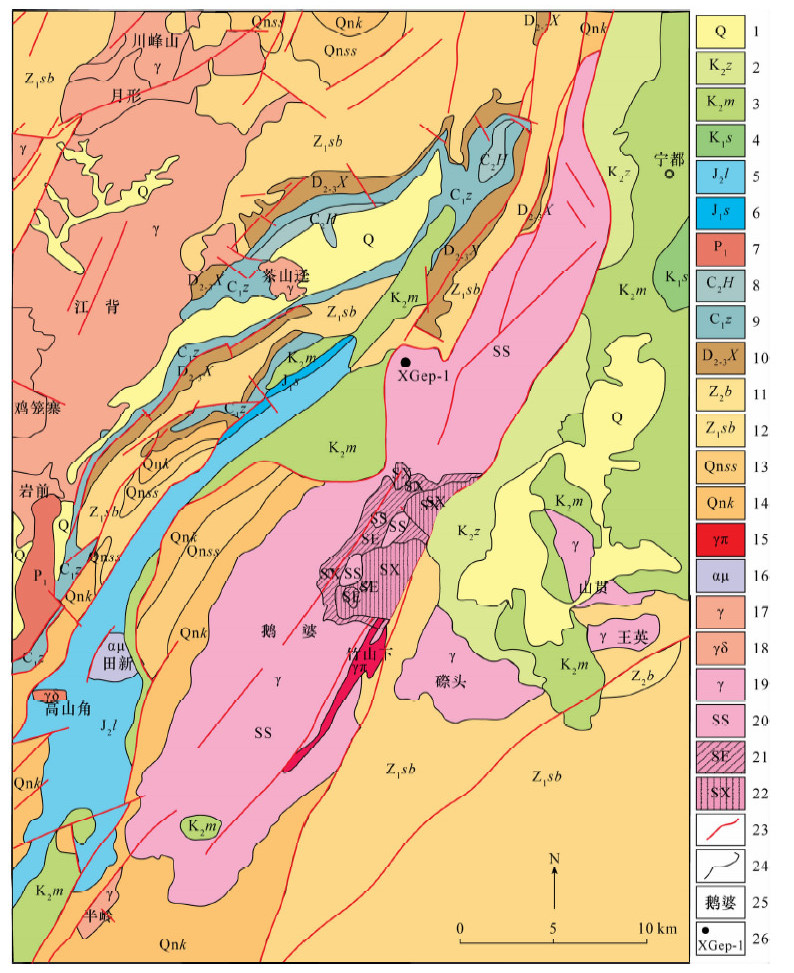
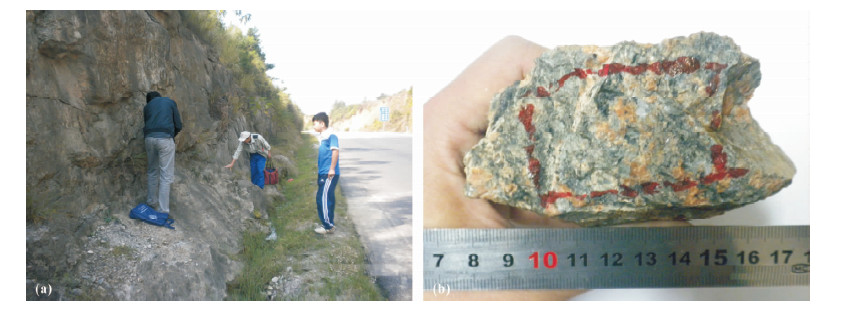

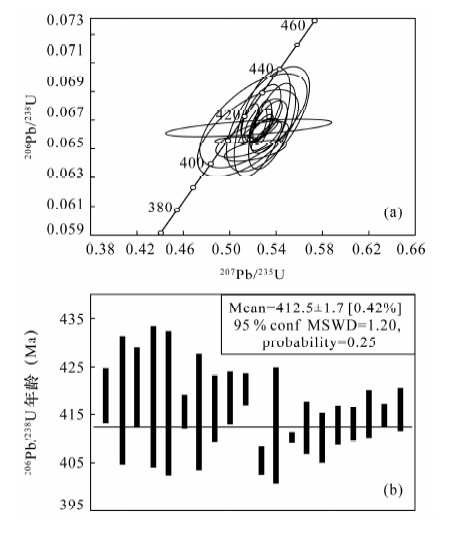
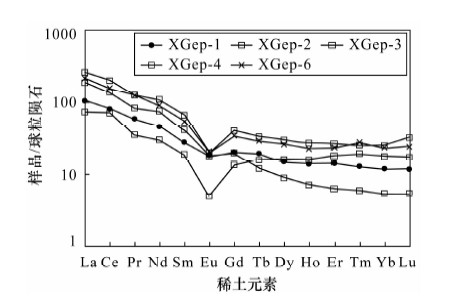
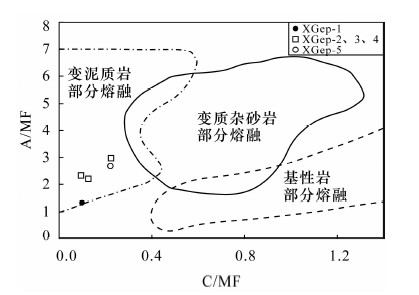
 京公网安备 11010202008159号
京公网安备 11010202008159号